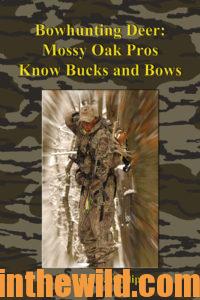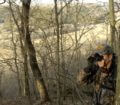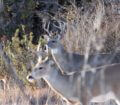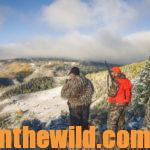Editor’s Note: To learn more about the deer living on your hunting-club or hunting-lease lands, I’ve talked with Brian Murphy, a wildlife biologist and the executive director for the Quality Deer Management Association (QDMA) https://www.qdma.com/, about the effective use of motion-sensor cameras for better deer management and to better protect deer. Murphy says that this type of deer census may capture photos of 95% of a deer herd in 10 days, as well as other wildlife.
 John E. Phillips: Brian, what are the other uses you’re seeing for motion-sensor cameras in the arena of quality deer management?
John E. Phillips: Brian, what are the other uses you’re seeing for motion-sensor cameras in the arena of quality deer management?
Brian Murphy: One of the really-neat things about motion-sensor cameras is they can and will photograph wildlife that you may not have known you have on your property, perhaps bobcats, foxes, possibly a bear, a mountain lion and/or wild hogs. We’ve had many landowners who’ve used motion-sensor cameras tell us about animals they’ve had no idea are living on their properties. Yet, the motion-sensor camera actually has photographed that animal(s).
A good example was when a friend of mine, another deer consultant, was doing a deer census on an island in Michigan called Fox Island. The island got its name because many years ago a fox had been seen on the island. However, in the last 20 years, no one had reported seeing a fox on that island. Everyone assumed that all the foxes had died out. But, while doing a camera census for deer, the cameras photographed a fox, proving that at least there was one fox still living on Fox Island.
Many times we’ll have hunters report that they’ve taken pictures of trophy bucks on their lands that no one ever has spotted. These hunters never will have known that they’ve got a 150+ Boone and Crockett buck on their property if they haven’t used motion-sensor cameras to inventory their wildlife. Too, motion-sensor cameras can solve landowner disputes. For instance, if you have a neighbor who has a dog that gets loose and chases deer on your property, but the neighbor refuses to believe that his dog ever leaves the yard, then if you’ve got a picture of the dog on your property taken by one of your cameras, you have evidence that in fact the dog does come on your property.
Patterning Buck Deer on Your Property:
But the most-obvious use of motion-sensor cameras for most hunters is to try and pattern an individual buck and determine where he’s coming from, where he’s going, and what time of day and night he’s moving. If you use motion-sensor cameras prior to hunting season, triangulate the route the buck travels and identify the time when he normally travels there, you can get a good idea of where you need to set up to take that buck. If you use three different motion-sensor cameras for instance on a 100-acre piece of property, you can determine where a buck is at three various times of the day, if he walks in front of those cameras. Then you can quickly and efficiently pinpoint the routes he’s traveling.
 A great example of how effective motion-sensor cameras can be for hunters is what happened to my friend Jeff Banks. He photographed a very-large buck on his hunting property that looked as though it would score close to 200 inches on Boone & Crockett. When Jeff took the buck, it did score almost 200 inches and was the biggest buck killed in the state of Georgia that year. Using trail cameras, he’d collected a number of pictures of this buck prior to deer season and had worked out a pattern where this buck had been photographed by all three cameras at certain times. So on opening day, he went out and set in the middle of the triangle where he knew the buck had been traveling and bagged this buck that scored 197 inches, a whopping-size buck. Motion-sensor cameras are great hunting and management tools and are fun to use before, during and after deer season.
A great example of how effective motion-sensor cameras can be for hunters is what happened to my friend Jeff Banks. He photographed a very-large buck on his hunting property that looked as though it would score close to 200 inches on Boone & Crockett. When Jeff took the buck, it did score almost 200 inches and was the biggest buck killed in the state of Georgia that year. Using trail cameras, he’d collected a number of pictures of this buck prior to deer season and had worked out a pattern where this buck had been photographed by all three cameras at certain times. So on opening day, he went out and set in the middle of the triangle where he knew the buck had been traveling and bagged this buck that scored 197 inches, a whopping-size buck. Motion-sensor cameras are great hunting and management tools and are fun to use before, during and after deer season.
Too, I genuinely believe that the motion-sensor camera has advanced our knowledge of deer, the biology of deer and the behavior of deer as much as anything, with the exception of the radio collar developed and used for studying whitetails. You don’t have to be a wildlife biologist to use a motion-sensor camera to determine deer movement and behavior. With the pictures you take, you can see how deer grow, watch fawns turn into yearlings, see yearlings become 2-1/2-year-old bucks and watch the size and antler growth of bucks over the years. If trail cameras are used wisely, they can provide plenty of useful information to deer hunters, landowners, wildlife biologists and anyone else who wants to know, “What kind of animals are out in the woods?”
 To learn more about hunting deer, check out John E. Phillips’ book on “Bowhunting Deer: Mossy Oak Pros Know Bucks and Bows,” available at https://www.amazon.com/Bowhunting-Deer-Mossy-Pros-Bucks-ebook/dp/B013F0T58O.
To learn more about hunting deer, check out John E. Phillips’ book on “Bowhunting Deer: Mossy Oak Pros Know Bucks and Bows,” available at https://www.amazon.com/Bowhunting-Deer-Mossy-Pros-Bucks-ebook/dp/B013F0T58O.
 To receive your free book on “How to Make Venison Jerky,” go to https://www.emailmeform.com/builder/form/Ece3UZVcOo52cKPJcL
To receive your free book on “How to Make Venison Jerky,” go to https://www.emailmeform.com/builder/form/Ece3UZVcOo52cKPJcL










